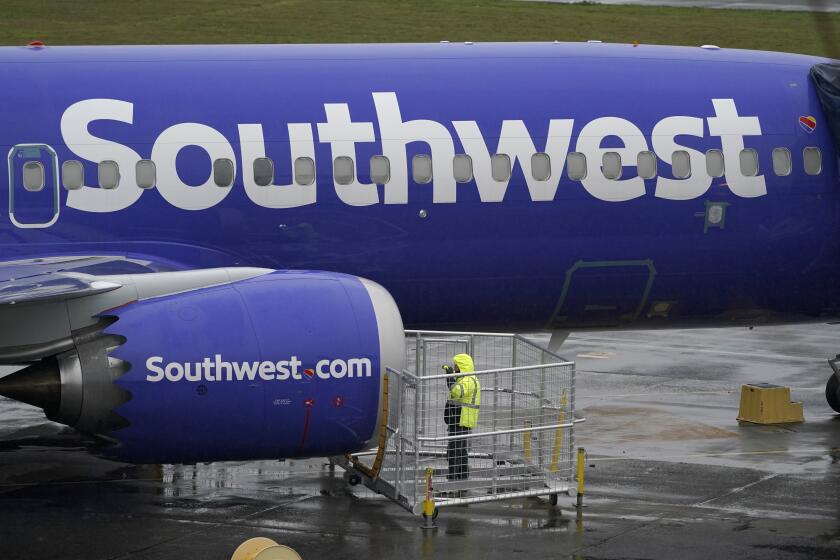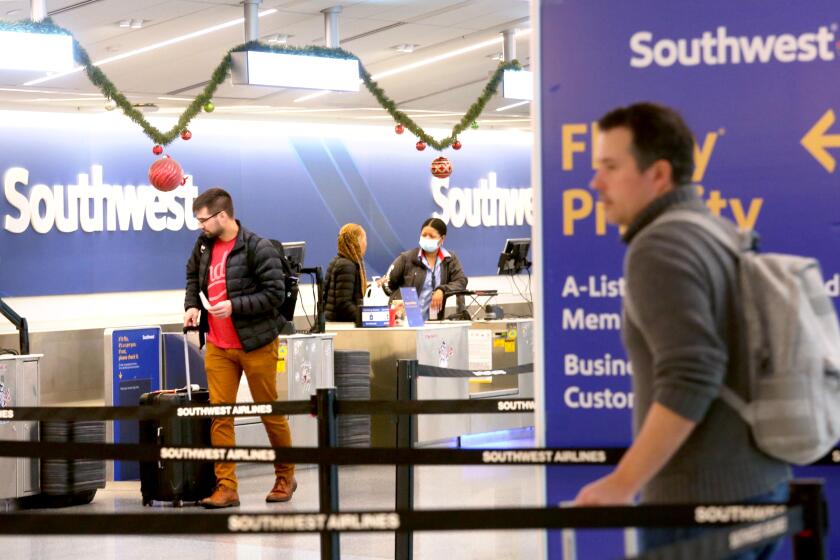
- Share via
Thousands of canceled flights. Countless separated bags. Millions of angry passengers.
Southwest Airlines’ costly holiday meltdown highlighted how quickly airline operations can go off the rails, particularly when you add bad weather to the complex calculation of how to get crews on the right planes at the right time.
The Dallas-based airline has pledged to do better. Southwest’s chief executive said the company would invest more than $1 billion to upgrade its IT system, and on Thursday during the first quarterly investor call since the fiasco, company executives spent significant time pledging that the year-end failures would not be repeated. In all, the company canceled more than 16,700 flights, sharply more than other airlines, which recovered faster from the multi-state storms than Southwest did.
“We disrupted thousands and thousands of customers at a critical point in time,” Southwest Chief Executive Bob Jordan said during the call. “I can’t apologize enough for that. I own that, and we will do everything it takes to make sure we don’t have an event like that again.”
But as climate change continues to make once-extreme weather events more routine, and airlines pack more passengers onto planes to increase efficiency and lower prices, a single disruption can throw the whole air travel system into chaos.
“It’s a commodity where everyone can fly and most people do,” said Ernest Arvai, president and co-founder of AirInsight, an aviation news and consulting site. “But if something goes wrong, there’s not enough slack left in the system to accommodate everyone quickly.”
Southwest is paying dearly for the December disaster.
The company said Thursday that an $800-million financial hit from the episode caused a net loss of $220 million for the last three months of 2022. Some travelers have since been avoiding the airline, decisions that will cause another loss in the first quarter of this year, Jordan said. The company expects that things will turn around by March.
“There are things we need to work on as we continue to grow this operation,” Jordan said during the call.
Though much maligned as a major factor in the carrier’s slow recovery from weather-related flight cancellations, Southwest’s unique point-to-point system is a way for the airline to set itself apart in a competitive marketplace.
Flying from one destination to another, rather than through the traditional hub-and-spoke network used by many large airlines, allows Southwest to offer nonstop flights to many locations throughout the United States that aren’t being served with direct flights by other major airlines, said Laurie Garrow, professor and aviation expert at Georgia Tech.
The lack of hubs also means Southwest can spread out its labor costs instead of needing large numbers of employees during peak times at locations where many planes arrive at the same time. If a location has less demand than expected, it’s easier to move planes than relocate an entire hub.
However, the hub-and-spoke network is more resilient because there are more pilots and crew members in a single location. If something happens with one flight, there are crew members and planes nearby to help with a faster recovery.
In Southwest’s case, the complexity of its point-to-point system crashed into the antiquity of its crew scheduling system, leaving the carrier struggling longer than other airlines to return to normal operations, Southwest’s pilots union and aviation experts said.
The Southwest Airlines Pilots Assn. said the processes used by the airline to connect crews with planes have eroded over the years, leaving pilots stranded in hotel rooms or being shuttled via other passenger flights to their destination even in the best of times.
“We are a very complex network,” said Capt. Casey Murray, president of the Southwest pilots union. “It’s much more difficult not only to manage but recover.”
American Airlines posted better-than-expected fourth-quarter profit, while Southwest Airlines lost money because of massive flight cancellations last month.
While the airline’s point-to-point network is the “magic that has allowed Southwest to succeed” and grow, Murray said the company hasn’t invested in the infrastructure or processes to make it more resilient to major disruptions.
Southwest officials said Thursday that a fix to the crew scheduling software is being tested now and that better communication with crew is being discussed in ongoing union negotiations.
A Times analysis of the late-December performance of Southwest and American Airlines, the nation’s largest carrier, showed that before the storms on Dec. 18, Southwest had a lower cancellation rate (0.05%) than American (1.18%).
By Dec. 23, as ferocious and deadly winter storms hit a large part of the nation, Southwest’s cancellation rate hit 34.63% while American was at 30.91%. That was the highest cancellation rate for American — after that, the airline largely recovered.
But Southwest’s cancellations kept climbing to a high of 76.22% on Dec. 26, long after the major inclement weather had passed. Southwest continued to cancel over 50% of its flights until the rate suddenly dropped to 1% on Dec. 30.
During the meltdown, Southwest also was forced to fly more than 700 nonpassenger flights to reposition crew and planes, adding to the episode’s financial hit.
“We can’t continue to be unreliable and not provide our customers with a sense of that reliability,” Murray said. “The future of Southwest Airlines is at stake.”
And that future may not be up to just Southwest.
Shortly after the December debacle, the U.S. Department of Transportation announced it was looking into the incident. In a statement to The Times on Wednesday, a department spokesperson said the agency is in the “initial phase of a rigorous and comprehensive investigation,” and that the department has made clear to the airline it will face consequences if it doesn’t make timely refunds and reimbursements to customers.
The Transportation Department is also looking into whether Southwest executives “engaged in unrealistic scheduling of flights” — meaning the carrier had scheduled more flights than it could possibly have handled under the circumstances — which is considered an unfair and deceptive practice under federal law, the spokesperson said.
On Thursday, Southwest officials said they will cooperate fully with the investigation and that the airline’s recent on-time performance and reliability show that the airline’s schedule is viable.
Southwest’s stated effort to fix its problems with new software and systems is a good step, but it can’t happen instantaneously, said Arvai of AirInsight.
“All we need is one giant storm, and will we have a repeat of what happened a few weeks ago?” he said.
‘It was horrible’: Stranded Southwest passengers still waiting to recoup costs from airline meltdown
Many Southwest Airlines passengers are still waiting to be reimbursed for costs they incurred during last month’s meltdown.
In the future, Southwest may want to cancel more flights ahead of poor weather to prevent the domino effect that happened this time, said Garrow of Georgia Tech.
“There’s a big incentive for Southwest to get this right,” she said. “Making some of the long-term infrastructure investments will help, but I think the real test is if you’re able to get your operational performance back up to the level of your competitors.”
But the narrow margin for error across the airline industry means that Southwest will not be the last airline in the future to face extreme disruption. Fuller planes mean there are fewer open seats to accommodate those passengers.
“The problem is, when disruption happens, how big is the disruption and how quickly can the airline come back with minimal cancellations, minimal delays and get back to normal operations?” said Ahmed Abdelghany, associate dean for research and professor of operations management at Embry-Riddle Aeronautical University. “At this level, we don’t have a way to completely eliminate this problem from the system.”
More to Read
About this story
Southwest Airlines flights with call signs starting with an 8, and American Airlines flights with call signs starting with a 9, were used to identify so-called “re-orienting flights.” Referred to in the story as “non-passenger flights,” these planes contained only pilots or crew. They were made to move planes or crew to locations where they were needed for the airline to resume normal operations.
In the interactive maps, flights are mapped according to local time at origin airports. Flights that were missing dates, destinations, origins or operator values were omitted from this analysis. Flights to Puerto Rico, Hawaii and Alaska were included in the analysis but are partially cut off from the map.
This story was edited by Sean Greene and Nancy Rivera Brooks.
Inside the business of entertainment
The Wide Shot brings you news, analysis and insights on everything from streaming wars to production — and what it all means for the future.
You may occasionally receive promotional content from the Los Angeles Times.















